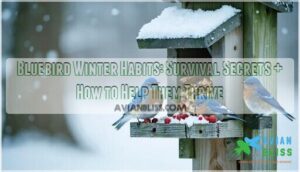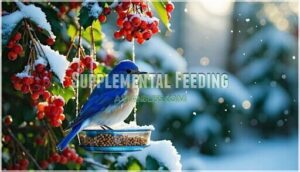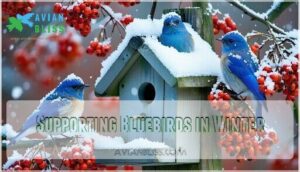This site is supported by our readers. We may earn a commission, at no cost to you, if you purchase through links.
 You’ll discover that bluebird winter habits aren’t what most people expect.
You’ll discover that bluebird winter habits aren’t what most people expect.
While some migrate south, many stick around year-round, completely changing their survival game plan.
They ditch their summer insect diet for berries, fruits, and whatever you put in your feeder, becoming opportunistic feeders, and hitting up bird feeders stocked with mealworms and suet.
Here’s the clever part: they team up, forming loose flocks and cramming into nest boxes together—sometimes twenty birds huddled like feathered sardines to stay warm.
These behavioral shifts reveal just how adaptable these vibrant survivors really are, but their success depends heavily on smart habitat choices.
Table Of Contents
- Key Takeaways
- Eastern Bluebird Winter Behavior
- Winter Feeding for Bluebirds
- Bluebird Residential Patterns
- Bluebird Winter Range
- Eastern Bluebird Migration Overview
- Supporting Bluebirds in Winter
- Ways to Aid Bluebirds in Massachusetts
- Frequently Asked Questions (FAQs)
- What do bluebirds do in the winter?
- Where do bluebirds sleep at night in winter?
- Should you feed bluebirds in the winter?
- Do bluebirds come back to the same house every year?
- Should I feed bluebirds in winter?
- Do bluebirds come back to the same place every year?
- Do bluebirds stay in the northeast all winter?
- Do bluebirds change their plumage color in winter?
- How do bluebirds communicate during the winter months?
- Can bluebirds recognize individual humans in winter?
- Conclusion
Key Takeaways
- You’ll find that many bluebirds don’t migrate south – instead, they become year-round residents in milder regions, completely changing their survival strategy for the winter months.
- They switch from insects to berries and fruits when cold weather hits, becoming opportunistic feeders that’ll also visit your bird feeders stocked with mealworms and suet.
- You can help them survive by providing roosting boxes and supplemental food – these birds huddle together communally in nest boxes (sometimes 20+ birds) to share body heat during frigid nights.
- Their winter success depends on smart habitat choices – they form loose flocks, reduce activity to conserve energy, and can lower their body temperature by 10-15 degrees to survive harsh conditions.
Eastern Bluebird Winter Behavior
Winter transforms eastern bluebirds into resourceful survivors through remarkable behavioral changes.
You’ll witness these vibrant songbirds abandoning their solitary summer habits for winter socialization, huddling together in tree cavities and birdhouses during frigid nights.
Their cold weather adaptations include switching from insects to berries and fruits, while energy conservation becomes paramount—they’ll reduce activity levels and enter nocturnal hypothermia, lowering body temperature by 10-15 degrees.
Predator avoidance drives their selection of secure roosting sites, often communal boxes that provide warmth and protection.
These bluebird winter habits showcase nature’s ingenuity, as bluebird winter survival depends entirely on bluebird winter roosting strategies and adaptive bluebird feeding habits that sustain them through harsh months.
Winter Feeding for Bluebirds
During winter months, bluebirds face a dramatic food shortage as insects become scarce, forcing them to adapt their diet to survive harsh conditions.
You’ll find these resourceful birds switching from their preferred insect meals to readily available berries and fruits that remain accessible throughout the cold season.
Natural Food Sources
As autumn frosts arrive, bluebirds face insect scarcity and must adapt their foraging strategies to survive winter’s challenges.
These adaptable songbirds shift from hunting insects to seeking winter fruit abundance from native berry bushes and wild grapes in foraging edge habitats.
Bluebirds rely heavily on natural bluebird food sources during cold months, with their bluebird winter diet consisting primarily of berries and fruits.
They may also seek shelter in nesting boxes as roosts at night.
Here’s how to support their natural feeding needs:
- Preserve native berry bushes like dogwood, sumac, and holly that provide essential winter nutrition
- Maintain open areas around fruiting trees to create accessible foraging edge habitats
- Reduce pesticide use to guarantee occasional insects remain available as supplemental protein
- Create brush piles near berry sources to offer shelter while birds forage for wild grapes and other fruits
Supplemental Feeding
Beyond their natural winter diet, you can boost bluebird survival by offering supplemental food at strategically placed bird feeders.
Mealworm benefits include high protein content that mimics their preferred insects. Suet options provide essential fats for energy, while fruit choices like softened raisins complement their berry-heavy winter diet.
Consider purchasing bluebird mealworms to supplement their diet.
Water availability remains essential for digestion and hydration during bluebird winter care.
Bluebird Residential Patterns
You might think all bluebirds pack up and head south when winter arrives, but that’s not the whole story.
Resident Bluebirds stick around year-round in milder regions, showing remarkable Habitat Fidelity by returning to the same roosting areas season after season.
These hardy birds demonstrate sophisticated Winter Clustering behaviors, forming communal flocks of 5-20 individuals that huddle together in Roost Site Selection spots like tree cavities and nest boxes.
Territory Defense becomes less aggressive during winter months, allowing family groups to maintain bonds formed during breeding season.
Here’s what makes their resident strategies so effective:
- Winter clustering reduces energy expenditure by up to 20% through shared body heat
- Roost site selection focuses on south-facing, sheltered locations that block harsh winds
- Habitat fidelity guarantees birds know reliable food sources and safe roosting spots
Understanding these bluebird winter habits helps you provide better bluebird winter care through proper bluebird nest boxes winter placement and habitat management.
Bluebird Winter Range
Eastern bluebirds showcase remarkable Range Expansion as climate change shifts their winter territories northward.
You’ll discover these adaptable birds now wintering in regions once considered too harsh for survival.
| Region | Winter Status |
|---|---|
| Southeastern U.S. | Year-round residents |
| Northern breeding areas | Seasonal migrants |
| Mexico/Central America | Southern Limits destination |
| Northern Extremes | Situational winter presence |
| Edge habitats | Preferred winter zones |
Climate Impact drives this bluebird winter range evolution, with some populations becoming permanent residents where they once migrated through.
Despite Habitat Loss pressures, bluebird winter habits demonstrate their resilience in bluebird habitat winter conditions, adapting bluebird migration patterns for winter survival.
Eastern Bluebird Migration Overview
You’ll discover that eastern bluebirds follow three distinct migration patterns depending on their breeding location and local conditions.
Northern populations travel impressive distances—some covering over 1,400 miles from Canada to wintering grounds in Mexico and the southern United States.
Migration Distances
When exploring bluebird migration patterns, you’ll discover that Eastern Bluebirds showcase remarkable variation in their journey lengths.
Migration distances range from zero to over 2,000 miles, with most birds traveling between 100-1,200 miles from breeding grounds to winter territories.
Northern populations, particularly those from Canada and New England, undertake the longest journeys—often exceeding 1,400 miles to reach southern states and Mexico.
Meanwhile, southeastern birds may only shift locally or remain year-round residents.
Weather impact and food scarcity serve as primary distance factors determining how far these birds travel.
Severe winters push bluebirds further south, while mild conditions allow shorter migrations.
Bird migratory routes typically follow north-south corridors, though some western populations show east-west movement patterns.
Consider these incredible aspects of bird migration:
- Their precise navigation using celestial landmarks and magnetic fields
- The endurance to fly hundreds of miles over multiple days
- Their genetic influence guiding them to favorable wintering habitats.
Understanding winter migration patterns helps you better support these resilient songbirds during their challenging seasonal journeys.
Nocturnal Roosting
As darkness descends, Eastern Bluebirds transform their bluebird behavior winter patterns by seeking roosting sites in tree cavities, nest boxes, or woodpecker holes.
Their roosting selection prioritizes predator avoidance and thermal protection, leading to communal roosting as their survival strategy, with multiple birds sharing communal warmth in a single cavity.
During nocturnal roosting, bluebirds practice controlled hypothermia benefits, lowering body temperature to conserve energy.
Proper roost box design with snug dimensions mimics natural roosting habits, supporting these adaptive winter behaviors.
They may also use Purple Martin houses as alternative roosts.
Supporting Bluebirds in Winter
You can make a significant difference in bluebird winter survival by providing proper roosting boxes and maintaining natural food sources in your yard.
These simple conservation efforts help Massachusetts bluebirds endure harsh winter conditions while supporting local bird populations year-round, which can be considered a significant difference.
Setting Up Roosting Boxes
Box Placement matters tremendously for Eastern Bluebird winter survival. Position your roosting boxes in open areas facing south or southeast to maximize sun exposure and warmth.
Mount them 5-10 feet high on poles, ensuring they’re accessible for Box Maintenance yet safe from ground predators. Box Size should include a 1.5-inch entrance hole with ventilation near the top.
Box Insulation becomes essential – pack boxes with dry grass to create thermal barriers against harsh winter temperatures. For enhanced protection, consider insulated housing options.
Add Predator Guards below mounting points to protect roosting birds. Regular Box Maintenance involves removing old materials and checking for damage.
These birdhouses provide essential shelter that directly impacts bluebird winter habits, making your property a winter haven for these beloved birds during their most vulnerable season.
Massachusetts Bird Conservation
Beyond setting up roosting boxes, you can contribute to Massachusetts bird conservation efforts that directly support bluebird winter survival.
These statewide initiatives focus on three key areas:
- Habitat Preservation – Protecting open meadows and woodland edges where bluebirds forage and roost
- Nesting Initiatives – Installing and maintaining nest box trails across public lands and private properties
- Public Education – Teaching communities about invasive species control and climate impacts on bird winter survival strategies
Ways to Aid Bluebirds in Massachusetts
Massachusetts residents can make a real difference for Eastern bluebird populations through targeted conservation efforts.
Your backyard becomes prime Massachusetts Habitats when you install specialized Winter Shelters like insulated roosting boxes, which reduce mortality by 45% during harsh conditions. Plant native berry-producing shrubs such as winterberry, dogwood, and sumac to boost Food Availability throughout cold months.
Set up protected feeders stocked with mealworms, suet cakes, and dried fruits to supplement their diet when insects disappear. Avoid pesticides to preserve vital insect populations that sustain these birds year-round.
To further attract birds, consider installing shallow birdbaths with fresh water. Community Involvement amplifies your impact substantially.
Join Local Conservation groups that monitor Bluebird Trails across Massachusetts, participate in citizen science projects, and help maintain nest boxes. These collaborative efforts create networks of safe havens, transforming individual yards into connected corridors that support thriving bluebird communities throughout the Bay State’s challenging winter habits season.
Frequently Asked Questions (FAQs)
What do bluebirds do in the winter?
You’ll find bluebirds switching from insects to berries and fruits, migrating south or staying put depending on location, and roosting communally in tree cavities to conserve warmth during harsh conditions.
Where do bluebirds sleep at night in winter?
When darkness falls, you’ll discover bluebirds huddling together in surprising shelter.
They roost communally in tree cavities, birdhouses, or roost boxes, sharing body heat to survive frigid nights and conserve precious energy.
Should you feed bluebirds in the winter?
Yes, you should feed bluebirds in winter.
They’ll appreciate mealworms, suet, softened fruits, and peanut butter since insects become scarce.
This supplemental feeding helps them meet higher energy demands during cold months.
Do bluebirds come back to the same house every year?
Bluebirds often return to their previous nesting territories, but they don’t reuse the same house.
They’ll choose new cavities each breeding season, though they may select boxes near their former homes if suitable options exist nearby, which can be considered a previous nesting strategy, and they may also look for nearby options.
Should I feed bluebirds in winter?
You should definitely feed bluebirds in winter! They’ll appreciate mealworms, suet, softened fruits, and peanut hearts since their usual insect diet becomes scarce during cold months.
Do bluebirds come back to the same place every year?
Picture faithful companions returning to familiar doorways each spring – that’s exactly what you’ll see with bluebirds.
Most return to territories they’ve used before, though exact nesting sites may vary within their established range.
Do bluebirds stay in the northeast all winter?
Most northeastern bluebirds don’t stick around all winter.
Northern populations typically migrate south between September and December, traveling to warmer states like Florida, Georgia, and the Carolinas to escape freezing temperatures.
Do bluebirds change their plumage color in winter?
Once yearly, bluebirds molt fresh feathers that appear brighter than their worn summer plumage.
However, you won’t see dramatic color changes – males keep their brilliant blue and orange hues while females maintain their subtle brown and blue tones throughout winter.
How do bluebirds communicate during the winter months?
During winter months, you’ll notice bluebirds communicate through soft chirps and calls rather than their elaborate breeding songs. They use simple contact calls to maintain flock cohesion while roosting communally.
Can bluebirds recognize individual humans in winter?
Surprisingly, birds like pigeons, magpies and jackdaws recognize individual human faces.
While research focuses on larger species, you can’t definitively know if bluebirds possess this winter recognition ability through visual cues alone.
Studies have shown that pigeons identify faces regardless of clothing, which demonstrates their ability to recognize human faces and remember them over time, showcasing a form of visual cues understanding.
Conclusion
Like adjusting rabbit ears on an old television, understanding bluebird winter habits helps you tune into their seasonal needs perfectly.
You’ve learned these adaptable birds don’t always migrate—many stick around, switching from insects to berries and relying on communal roosting for warmth.
By providing mealworms, suet, and proper nest boxes, you’ll support their survival through harsh months.
Your backyard can become a winter refuge, ensuring these brilliant blue survivors thrive when temperatures drop and natural food sources become scarce.









